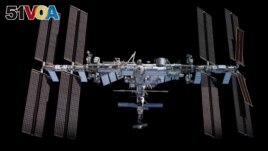01 October 2023
The American space agency NASA has a new plan for deorbiting the International Space Station (ISS). The plan involves developing a new spacecraft to safely guide the ISS during its final reentry through Earth's atmosphere.
NASA cooperates with four other space agencies on the station. These include the Canadian Space Agency, the European Space Agency, Japan's Aerospace Exploration Agency and Russia's Roscosmos.
The ISS began serving as a space research center more than 22 years ago. It has been widely praised as a scientific success. But, NASA and its international partners say the ISS has a limited technical lifetime. NASA has said it will keep operating and sending astronauts to the ISS until 2030.

This image depicts the International Space Station pictured from the SpaceX Crew Dragon Endeavour during a fly around of the orbiting lab. (Image Credit: NASA)
After that, the U.S. space agency plans to use privately developed space laboratories for its space research needs. NASA says this will permit it to pay space station operators only for the goods and services it needs.
NASA has already chosen several American companies to develop future space stations. These privately-operated stations will aim to serve the science needs of NASA, as well as other nations' space agencies and other organizations.
In a report to the U.S. Congress last year, NASA established its plans for the ISS. The report said the agency aims to make the station's final years its most productive. Among the goals NASA declared: "To support deep space exploration and continue to return medical and environmental benefits to humanity."
The agency recently announced its new deorbiting plan for the ISS after considering other options to retire it. A past plan, or option, involved the use of several Russian spacecraft. But NASA officials rejected that plan and decided a new, specially designed spacecraft would better serve the needs of the deorbiting operation.
Other options included a plan to take apart the space station in space and transport its pieces back to Earth. Another plan would have seen the ISS sent to a higher orbit, where it would remain out-of-service. A third option involved a non-controlled reentry operation. NASA said none of these met its requirements for safety and effectiveness.
The agency recently released a request for proposals to companies interested in building the new the spacecraft. NASA calls it the U.S. Deorbit Vehicle (USDV). It says it can be a completely new vehicle or an existing design that is changed to meet all needs of the deorbiting process. The agency said it is seeking proposals now because the effort "will take years to develop, test, and certify."
NASA has said when it is time to retire the ISS, it will begin taking the first steps to slowly lower its operating altitude. This part of the process can likely be carried out by the ISS and its systems, without the need for additional spacecraft.
But the final part of the operation, reentry, will center on guiding the ISS though Earth's atmosphere to a pre-chosen target in an unpopulated area in the ocean. NASA says this final part "is expected to require a new or modified spacecraft using a large amount of propellant."
The targeted landing spot has been identified as a place called Point Nemo in the South Pacific Ocean. This is a stretch of open water between New Zealand and the southernmost part of South America. The U.S. National Ocean Service identifies Point Nemo as the point in the ocean that is farthest from land.
NASA predicts that most ISS equipment will burn up or vaporize during the intense heating that happens during atmospheric re-entry. But it says some denser or more heat-resistant elements are expected to survive and land in the targeted ocean area.
I'm Bryan Lynn.
Bryan Lynn wrote this story for VOA Learning English, based on reports from NASA and Reuters.
_____________________________________________
Words in This Story
benefit – n. a good or helpful result
certify – v. to say in an official way that something is true or correct
modify – v. to change something in order to improve it
altitude – n. the vertical distance of an object above a given level (as sea level)
propellant – n. an explosive substance of fuel that causes something to move forward
vaporize – v. to turn, or cause something to turn, from a solid or liquid state into gas